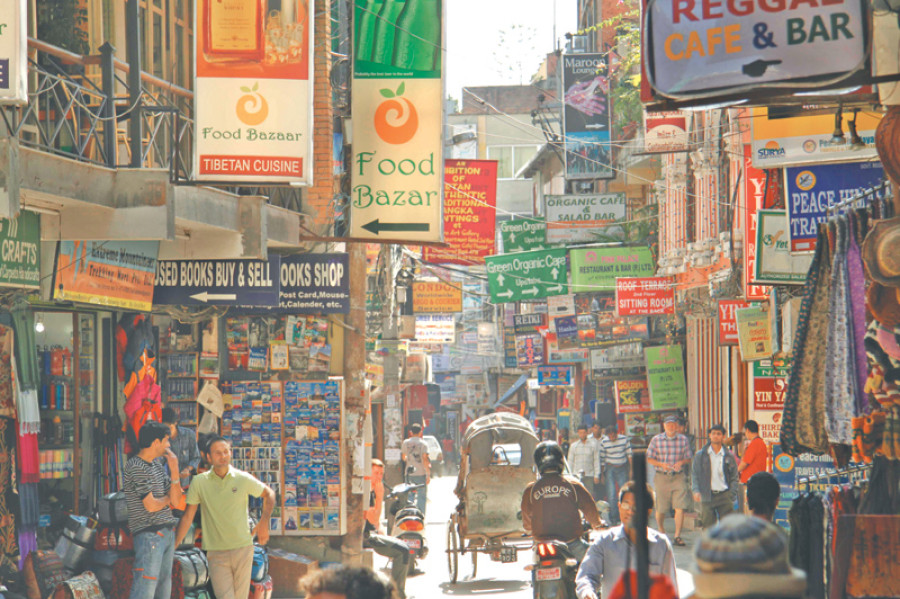Miscellaneous
A Thamel state of mind
In many ways, Thamel has come a full-circle at the 1,000-year-old Bhagwan Bahal (Bikramashila Mahabihar).
Sanjit Bhakta Pradhananga
In many ways, Thamel has come a full-circle at the 1,000-year-old Bhagwan Bahal (Bikramashila Mahabihar). Today, the monastic complex is constantly enveloped bythe clangouring of construction at the 14-storied, 76,000 square foot monstrosity that is the Chhaya Devi complex, being hoisted next door on land once held by the monastery. Here, Thabahi—once an outlying “gram” to Kathmandu’s urban core—and the hedonistic, modern, touristy district of Thamel stare down each other from across the street. And it is here that Rabi Thapa’s second book, Thamel: Dark Star of Kathmandu, that seeks to navigate the millennia that separate these two unlikely neighbours, begins.
In Thamel, Thapa undertakes the difficult task of maintaining the sharp eye of an investigative journalist, the natural curiosity of a historian and the Proustian reverie of an era that has come and gone, all strung together by prose that is lucid and replete with quotably memorable one-liners. Spread over 13 chapters, the book criss-crosses between solidly-researched historical narrative, incisive social commentary, personal memories and first-person recanting of six fascinating characters—an ageing cop, a self-made tourism entrepreneur, an elitist hair dresser, a nostalgic metal vocalist, a junkie, and a go-go girl. What emerges is a brutally honest cartography of a place where “Ganesh Man Singh hosted revolutionaries and summiteers, where a glue-sniffing, retarded street kid sleeps curled against a mongrel’s spine, where every Tom, Dick and Hari comes to see the world at play, hit-or-missing the centripetal centre of modern Nepal in all its gory glory, a thousand signs clamouring for your attention, bad at the best of times, sublime when you don’t expect it, the village all grown up and demanding a pair of Levi’s.”

No doubt Thamel has its limitations. It will naturally be most appealing to the 80s kids who saw the last whiffs of both the hippie and the Panchayat eras dissipate into the confused and chaotic 90s. A little less for the young-uns—the Cappuccino Generation—that came after. Lesser still for those who have never known Kathmandu, or, worse yet, for those who have only known it through “group tourist packages.”
In truth Thamel, like the place itself, is a lot of things. Its chapters named after themes ranging from Sepultura lyrics to Ram Dass’s magnum opus are more Lego pieces than they are an immovable whole—you could take them apart and rearrange in the order befitting the shade of your own tinted glasses. The history buff might see it as a no-nonsense commentary that doesn’t mince words for the Shahs, Ranas, Democrats or the Communists alike. Those with a tourism bend will see it as a fascinating study of the Nepali tourism industry’s evolution from the hidden Shangri-la, to the hippie Mecca, to an odd choice for a Stag Weekend destination, where by Nepal Tourism Board’s admittance “beautiful Nepali belles will dance circles around your pals.” The NGO-types might read in between the lines and interpret the book as one that lays bare the underbelly of the sensuous and unforgiving streets of Kathmandu’s tourism district. The literati, too, undoubtedly, will have their bits to swoon about.
But written in the “traditions of flanerie” without one character or theme to anchor down the many tangents, and with the narrative pinballing through centuries, Thamel, at times can be confusing, if rarely tedious. And in many ways, because of that, it perfectly encapsulates both Thamel the physical space and the state of mind. But Thamel is also remarkable because it is an absorbing biography of a place that is free from both the mires of overbearing scholarly work and the foggy haze of debilitating nostalgia. And if it inspires a new generation of Nepali writers to dare to research and write more than just run-off-the-mill short stories, it will have done much more than it sought out to do.
Photo courtesy: Richard Tulloch




 11.12°C Kathmandu
11.12°C Kathmandu








%20(1).jpg&w=300&height=200)

